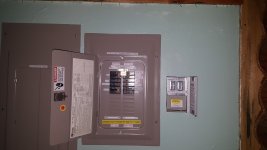CobyRupert
Super Member
Lenny: That shouldn't happen.
The neutral, from the utility transformer, is bonded to ground (the earth, "0" volts, ground rods, etc.. ) at the first disconnect from the utility service point (usually by bonding neutral bus and ground bus in your main panel and connecting to ground rod). The neutral might also be grounded (with a ground rod) at the utility's transformer (especially if it's pad mounted). Only if your ground system and/or neutral bonding goes bad (neutral is "lifted") could neutral become energized.
The overwhelming majority of commercial residential transfer switches sold do not switch the neutral. When you plug the genny in, it uses the same ground and neutral system, and bonding point between the two, that your house does when on utility power.
(If you do have a rare transfer switch that switches the neutral your generator is now a "Separately derived system" and need ground rods, jumper bond at genny between neutral and ground, etc...etc..basically things get more complicated)
The reason why Fried's (-that's NOT a good name for someone doing electrical work!) method is "dangerous" (but often done) is because it relies on a human to remember the correct procedure when another human's safety depends on it, rather than a mechanical interlock. And that's not fair to the Lineman.
In reality if you try to energize the utility line:
- The lineman has probably grounded or shorted the lines he's working on so only smoke will come out of your genny (or breaker will hopefully trip)
- There's little chance your 10kW genny is going to backfeed through the ((say) pole mounted 13.2kv-120/240) transformer, power up the 13.2kv line and power all your neighbors on that line without instantly tripping out. - Though this depends on where the utility fault is and how many neighbors you're trying to power. Though I suppose theoretically, Lineman could still get a shock in that instant.
- When utility power comes back on and you (or someone else) messes up and turn on utility breaker into panel still supplied by active genny (or vice-versa)....you also may get some "magic smoke" escaping out of your genny.
The neutral, from the utility transformer, is bonded to ground (the earth, "0" volts, ground rods, etc.. ) at the first disconnect from the utility service point (usually by bonding neutral bus and ground bus in your main panel and connecting to ground rod). The neutral might also be grounded (with a ground rod) at the utility's transformer (especially if it's pad mounted). Only if your ground system and/or neutral bonding goes bad (neutral is "lifted") could neutral become energized.
The overwhelming majority of commercial residential transfer switches sold do not switch the neutral. When you plug the genny in, it uses the same ground and neutral system, and bonding point between the two, that your house does when on utility power.
(If you do have a rare transfer switch that switches the neutral your generator is now a "Separately derived system" and need ground rods, jumper bond at genny between neutral and ground, etc...etc..basically things get more complicated)
The reason why Fried's (-that's NOT a good name for someone doing electrical work!) method is "dangerous" (but often done) is because it relies on a human to remember the correct procedure when another human's safety depends on it, rather than a mechanical interlock. And that's not fair to the Lineman.
In reality if you try to energize the utility line:
- The lineman has probably grounded or shorted the lines he's working on so only smoke will come out of your genny (or breaker will hopefully trip)
- There's little chance your 10kW genny is going to backfeed through the ((say) pole mounted 13.2kv-120/240) transformer, power up the 13.2kv line and power all your neighbors on that line without instantly tripping out. - Though this depends on where the utility fault is and how many neighbors you're trying to power. Though I suppose theoretically, Lineman could still get a shock in that instant.
- When utility power comes back on and you (or someone else) messes up and turn on utility breaker into panel still supplied by active genny (or vice-versa)....you also may get some "magic smoke" escaping out of your genny.


